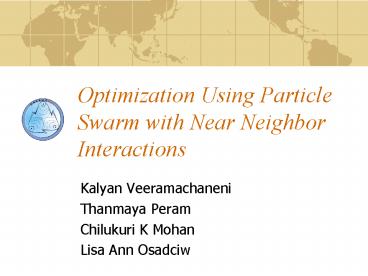Optimization Using Particle Swarm with Near Neighbor Interactions - PowerPoint PPT Presentation
1 / 23
Title:
Optimization Using Particle Swarm with Near Neighbor Interactions
Description:
Optimization Using Particle Swarm with Near Neighbor Interactions Kalyan Veeramachaneni Thanmaya Peram Chilukuri K Mohan Lisa Ann Osadciw Overview Introduction ... – PowerPoint PPT presentation
Number of Views:141
Avg rating:3.0/5.0
Title: Optimization Using Particle Swarm with Near Neighbor Interactions
1
Optimization Using Particle Swarm with Near
Neighbor Interactions
- Kalyan Veeramachaneni
- Thanmaya Peram
- Chilukuri K Mohan
- Lisa Ann Osadciw
2
Overview
- Introduction
- Motivation
- Fitness- Distance Ratio
- FDR-PSO Algorithm
- Particle Dynamics
- Experimental Settings
- Results and Analysis
- Related Work
- Summary
3
Introduction Particle Swarm Optimization
- Inspired from social impact theory
- Each particle influenced by its own previous
experience, pbest - Also influenced by local best in neighborhood,
lbest - Simulation results show that complete graph
topology yields better results than other
topologies
4
Motivation
- Problems with PSO execution
- Premature convergence
- Clustering of particles
- Goal To overcome these problems, exploiting
social impact theory
5
Fitness-Distance Ratio
- Evaluating influence of jth particle on the ith
particle (along the dth dimension) - where Pj is the previous best position
visited by the jth particle - Xi is the position of the particle under
consideration
6
FDR-PSO Algorithm
- Each particle influenced by
- Its own previous best (pbest)
- Global best particle (gbest)
- Particle that maximizes FDR (nbest)
- Velocity Update Equation
- Position Update Equation
7
FDR-PSO Algorithm
- Algorithm FDR-PSO
- For t 1 to the max. bound on the number of
generations, - For i1 to the population size,
- Find gbest
- For d1 to the problem
dimensionality, - Find nbest which maximizes the
FDR - Apply the velocity update
equation - Update Position
- End- for-d
- Compute fitness of the particle
- If needed, update historical
information regarding Pi and Pg - End-for-i
- Terminate if Pg meets problem
requirements - End-for-t
- End algorithm.
8
Particle Dynamics I
- Different nearest best neighbors for a particle
along different dimensions - Nearest best neighbor often poorer than global
best - Possible overlap between gbest or pbest and nbest
for small populations - Overlap of 40 found in a population size of 10
9
Particle Dynamics -II
- Greater exploration avoiding premature
convergence - Increased Population Diversity
10
Particle Dynamics -II
Average
Best
11
Particle Dynamics II
Average
Best
12
Experimental Settings - I
- Experimental Settings
Swarm Size Generations Dimensions Trials
10 1000 20 30
13
Experimental Settings - II
- FDR-PSO parameters
- Notation
- ?1, ?2, ?3 represent the weights given to pbest,
gbest and nbest terms respectively - Variations of FDR-PSO are obtained by varying the
three weights - PSO parameter selection
- Equal social and Cognitive learning rates
14
Results and Analysis -I
Axis Parallel Hyper Ellipsoid
15
Results and Analysis -II
Griewangks Function
16
Summary of Results
17
Results and Analysis III
- FDR-PSO variations consistently outperformed PSO
- FDR-PSO(112) was the best performer
- nbest term is more important for multimodal
functions
18
Performance of FDR-PSO Variations
- FDR-PSO(112) and FDR-PSO(012) outperform PSO on 5
out of 6 benchmark problems - FDR-PSO(102) outperform FDR-PSO(111) in 4 out of
6 benchmark problems - FDR-PSO(002) outperforms FDR-PSO(111) and PSO in
3 out of 6 benchmark problems
19
Related Work
- ARPSO Diversity measurement makes the algorithm
alternate between attraction and repulsion phases - PSO with mass extinction (HPSO) Velocities are
reinitialized after each extinction interval - Hybrid PSO Population is split into
subpopulations and PSO algorithm is hybridized
with features from genetic algorithms
20
FDR-PSO Vs Other Variations -I
21
FDR-PSO Vs Other Variations -II
- Many PSO variations introduce additional control
parameters which are not easy to determine - FDR-PSO achieves better minima without any
additional parameters - Other variations are extrinsic to particle
dynamics, and hence can be applied to FDR-PSO as
well
22
Summary
- Designed a new algorithm which partly follows
social impact theory - Modeled the Fitness-Distance Ratio metric
- Improved performance compared to PSO and its
previous variations - Significantly less affected than PSO by problems
such as premature convergence, loss of diversity
in population
23
Development and Research in Evolutionary
Algorithms for Multisensor Smart Networks
- DreamsNet
- 277, Link Hall
- Syracuse University
- Syracuse, NY 13244































